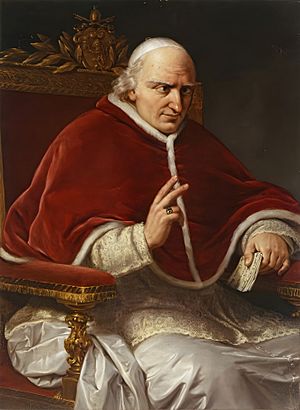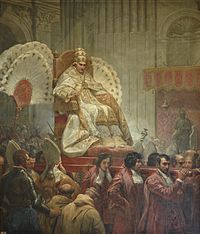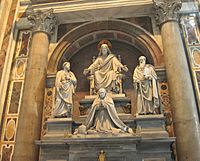Pope Pius VIII facts for kids
Quick facts for kids Pope Pius VIII |
|
|---|---|
| Bishop of Rome | |

Portrait by Clemente Alberi, c. 1830
(oil on canvas, 100 x 75 cm, Pinacoteca Civica di Forlì) |
|
| Church | Catholic Church |
| Papacy began | 31 March 1829 |
| Papacy ended | 30 November 1830 |
| Predecessor | Leo XII |
| Successor | Gregory XVI |
| Orders | |
| Ordination | 17 December 1785 |
| Consecration | 17 August 1800 by Giuseppe Maria Doria Pamphilj |
| Created Cardinal | 8 March 1816 |
| Personal details | |
| Birth name | Francesco Saverio Maria Felice Castiglioni |
| Born | 20 November 1761 Cingoli, Marche, Papal States |
| Died | 30 November 1830 (aged 69) Quirinal Palace, Rome, Papal States |
| Previous post |
|
| Signature | |
| Coat of arms |  |
| Other Popes named Pius | |
Pope Pius VIII (born Francesco Saverio Maria Felice Castiglioni; 20 November 1761 – 30 November 1830) was the leader of the Catholic Church. He also ruled the Papal States, which were lands controlled by the Pope, from March 1829 until his death in November 1830.
Pius VIII's time as Pope was the shortest in the 1800s. It is also one of the least remembered. During his short rule, an important event called the Catholic Emancipation happened in Great Britain in 1829. This gave more rights to Catholics. He was happy about this. Another big event was the July Revolution in France in 1830, which he accepted, though not eagerly.
Pope Pius VIII is often remembered for his rules about marriages between Catholics and Protestants. In a letter from 1830, he said that such marriages could only be properly blessed if the children would be raised in the Catholic faith. He died less than two years after becoming Pope. Some people have wondered if he was murdered, but there is no proof.
Contents
Early Life and Education
Francesco Saverio Castiglioni was born in Cingoli, Italy, on November 20, 1761. He was the third of eight children. His family was important, and one of his ancestors was even a Pope, Pope Celestine IV.
Francesco studied at a school run by the Society of Jesus, also known as the Jesuits. After that, he went to the University of Bologna. In 1785, he earned a special degree in church law and civil law. He became a priest in Rome on December 17, 1785.
Before becoming a bishop, he worked in several towns. He was a Vicar General, which is a high-ranking church official, in Anagni, Fano, and Ascoli Piceno.
Becoming a Bishop and Cardinal
On August 11, 1800, Francesco Castiglioni became the Bishop of Montalto. He was officially made a bishop in Rome on August 17.
During this time, Napoleon was very powerful in Europe. Bishop Castiglioni refused to promise loyalty to Napoleon or his government in Italy. Because of this, he was arrested in 1808 and moved to different cities. He was finally able to return to his diocese in 1814 after Napoleon lost power.
Pope Pius VII was very impressed by Castiglioni's loyalty. In 1816, Pope Pius VII made him a Cardinal. Cardinals are high-ranking church officials who help the Pope and elect new Popes. Castiglioni then held several important jobs in the Church. He later became a Cardinal-Bishop, which is an even higher rank.
In 1823, when the Pope died, Cardinal Castiglioni was considered a top candidate to become the next Pope. Pope Pius VII even used to call him "Pius VIII." However, he didn't get enough votes that time. Instead, Pope Leo XII was chosen.
Papacy: Leading the Church
| Papal styles of Pope Pius VIII |
|
|---|---|
 |
|
| Reference style | His Holiness |
| Spoken style | Your Holiness |
| Religious style | Holy Father |
| Posthumous style | None |
Election as Pope
After Pope Leo XII died in 1829, Cardinal Castiglioni was again a strong candidate to become Pope. People were worried about his health because he was often sick. But despite these worries, he was chosen as Pope in the papal election of 1829. Since Pope Pius VII had called him "Pius VIII," it seemed right that he chose that name. He was crowned Pope on April 5, 1829.
A powerful Cardinal named Giuseppe Albani played a big role in his election. Albani believed that Castiglioni's poor health meant he would be Pope for only a short time. Albani wanted to be the Pope's main helper, the Secretary of State, and have a lot of power. He made a deal with Castiglioni, who agreed. Once Castiglioni became Pope, Albani got the job he wanted.
Important Decisions and Views
As Pope Pius VIII, he started some changes in the Papal States. In May 1829, he wrote an important letter called Traditi humilitati. In this letter, he said that Catholicism was the one true religion. He warned against ideas that said all religions were the same.
In March 1830, he wrote another letter called Litteris altero. In this letter, he spoke out against secret societies like the Masons. He also warned against new translations of the Bible that he felt were not correct.
Pope Pius VIII also talked about mixed marriages, which are marriages between a Catholic and a Protestant. He allowed these marriages in places like Germany, but he was stricter in places like Ireland and Poland, where most people were Catholic. He said that a mixed marriage could only be blessed by a priest if the couple promised to raise their children as Catholics.
Other Activities as Pope

During his short time as Pope, two major events happened in Europe. The first was the Catholic Emancipation in the United Kingdom in 1829. This law gave Catholics more freedom and rights. The second was the July Revolution in France in 1830. This revolution changed the king of France. Pope Pius VIII recognized the new French king, Louis Philippe I.
Pope Pius VIII was also known for changing a rule about money. He allowed people to charge a small amount of interest on loans. This was a big deal at the time.
He was also popular for removing "cancelletti" (grids) from taverns. The previous Pope had put these grids there to stop people from drinking wine unless they also ate a meal. A funny poem was written about him: "When the great Pius / appeared before God / He asked him: What have you done? / He answered: 'I've done nothing.' / But the little angels knew better: / 'He removed the little grids!'"
New Cardinals
Pope Pius VIII held three special ceremonies to appoint new cardinals. He appointed a total of six men to become cardinals. He also secretly chose eight more cardinals, but he died before he could announce their names. So, those appointments didn't count.
Beatifications
He did not make any new saints during his short rule. However, he did beatify two people, which is the step before becoming a saint. He beatified Benincasa da Montepulciano in December 1829 and Chiara Gambacorti in March 1830. In August 1830, he also gave Saint Bernard of Clairvaux a special title, "Doctor mellifluus" (Mellifluous Doctor), recognizing him as an important teacher of the Church.
Health and Death
Pope Pius VIII was not healthy for most of his time as Pope. He became very sick in November 1830. He had painful sores on his neck and knee, and his body was covered in blisters. Doctors tried to help him.
He became very ill again on November 23. He had trouble breathing for several nights. On November 28, he received special prayers and blessings for the sick. He died on November 30, 1830, at the age of 69, in the Quirinal Palace in Rome.
Some people have suggested that Pope Pius VIII was poisoned, but there is no evidence to prove this idea. After his death, the cardinals met to choose the next Pope, who became Pope Gregory XVI.
Episcopal Lineage
The Pope's episcopal lineage, also known as apostolic succession, shows a line of bishops who consecrated each other. This connects them back through history.
- Cardinal Scipione Rebiba
- Cardinal Giulio Antonio Santorio
- Cardinal Girolamo Bernerio
- Archbishop Galeazzo Sanvitale
- Cardinal Ludovico Ludovisi
- Cardinal Luigi Caetani
- Cardinal Ulderico Carpegna
- Cardinal Paluzzo Paluzzi Altieri degli Albertoni
- Pope Benedict XIII
- Pope Benedict XIV
- Cardinal Enrico Enríquez
- Archbishop Manuel Quintano Bonifaz
- Cardinal Buenaventura Fernández de Córdoba Spínola
- Cardinal Giuseppe Doria Pamphili
- Pope Pius VIII
See also
 In Spanish: Pío VIII para niños
In Spanish: Pío VIII para niños
- Cardinals created by Pius VIII
- List of popes
Literature
- Giuseppe Monsagrati: Pio VIII. In: Massimo Bray (ed.): Enciclopedia dei Papi, Istituto della Enciclopedia Italiana, Vol. 3 (Innocenzo VIII, Giovanni Paolo II), Rome, 2000,
- Bautz, Traugott, ed. (1994). "Pius VIII" (in de). Biographisch-Bibliographisches Kirchenlexikon (BBKL). 7. Herzberg: Bautz. cols. 673–677. ISBN 3-88309-048-4. http://www.bbkl.de/{{{1}}}.shtml.


